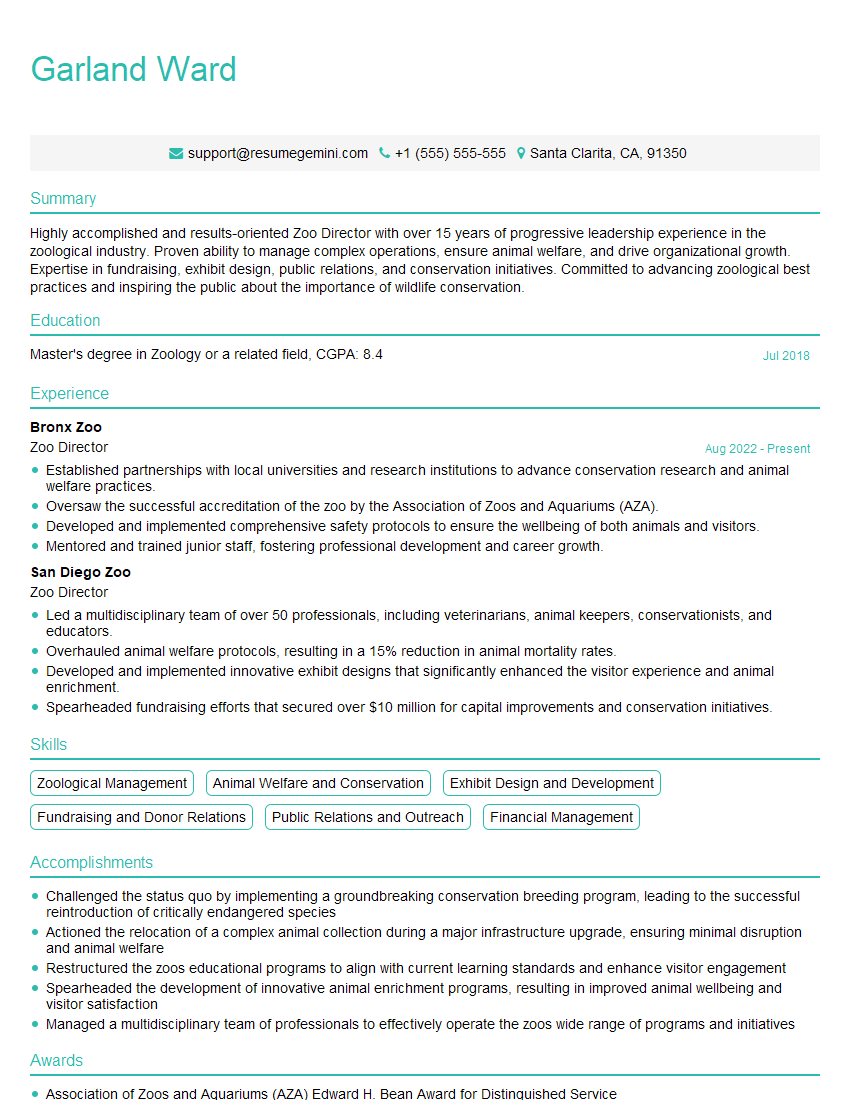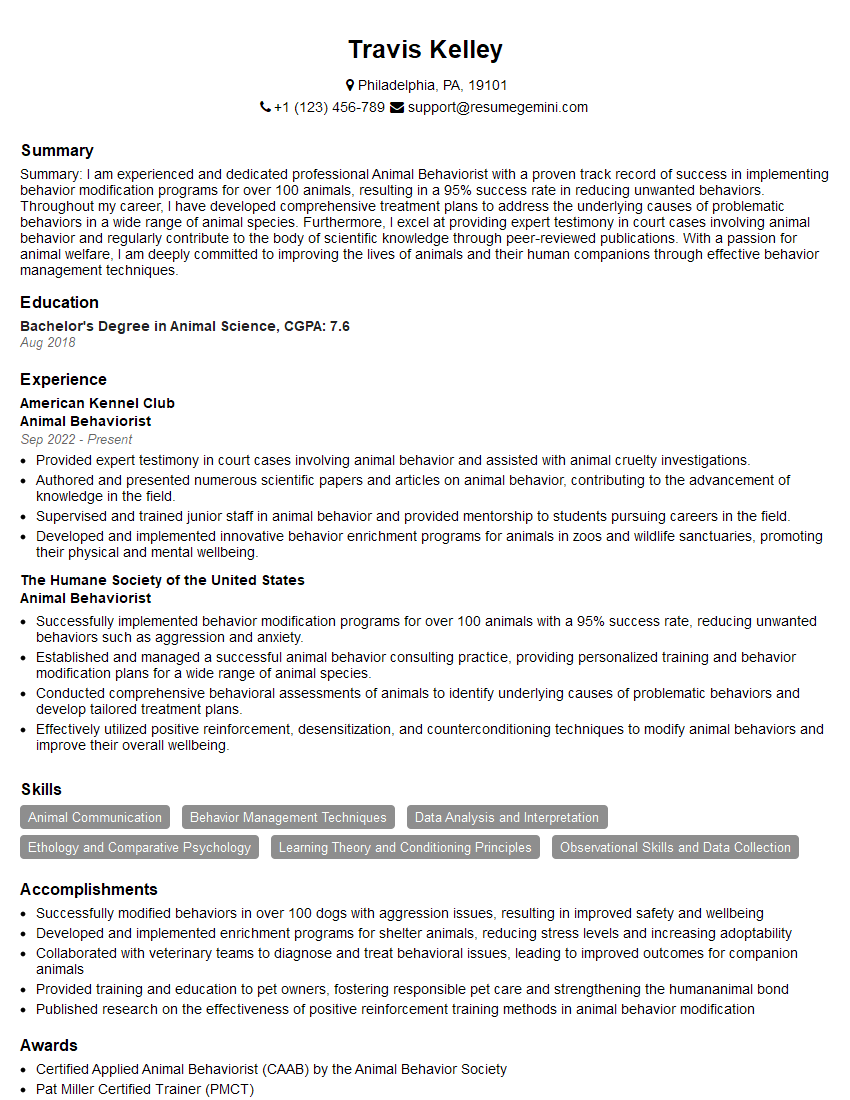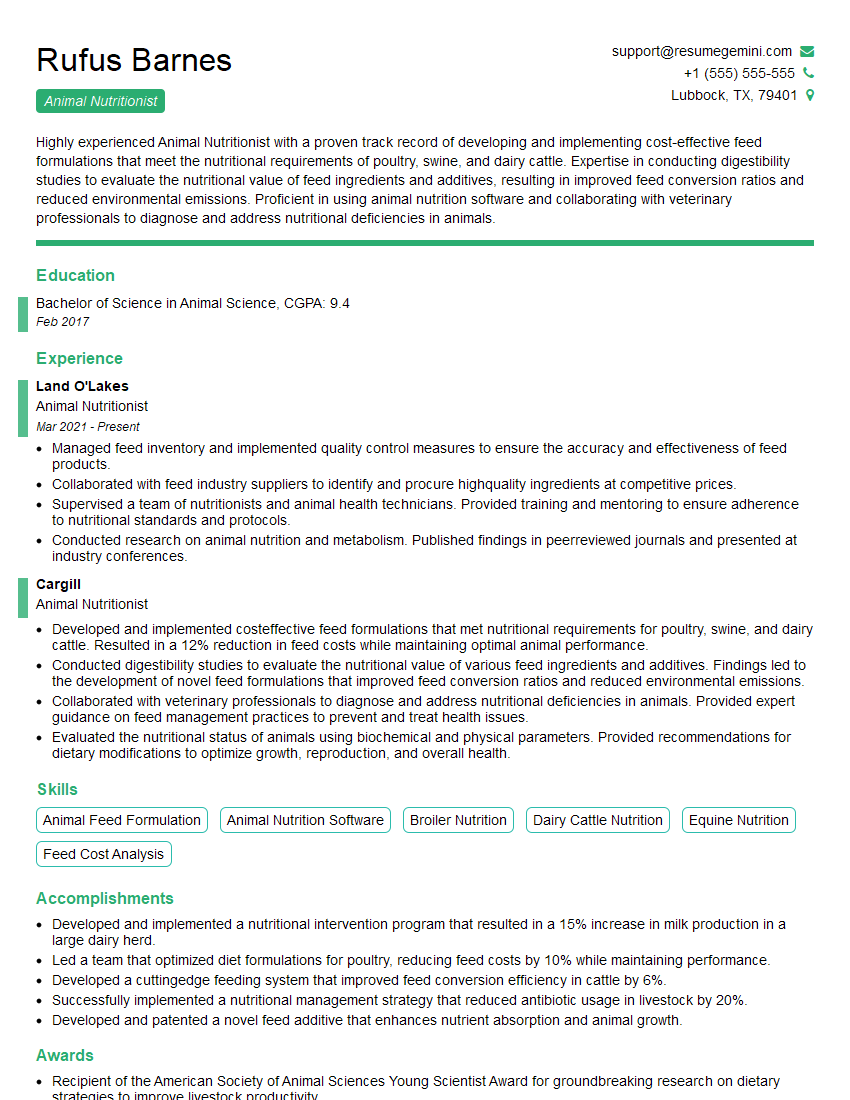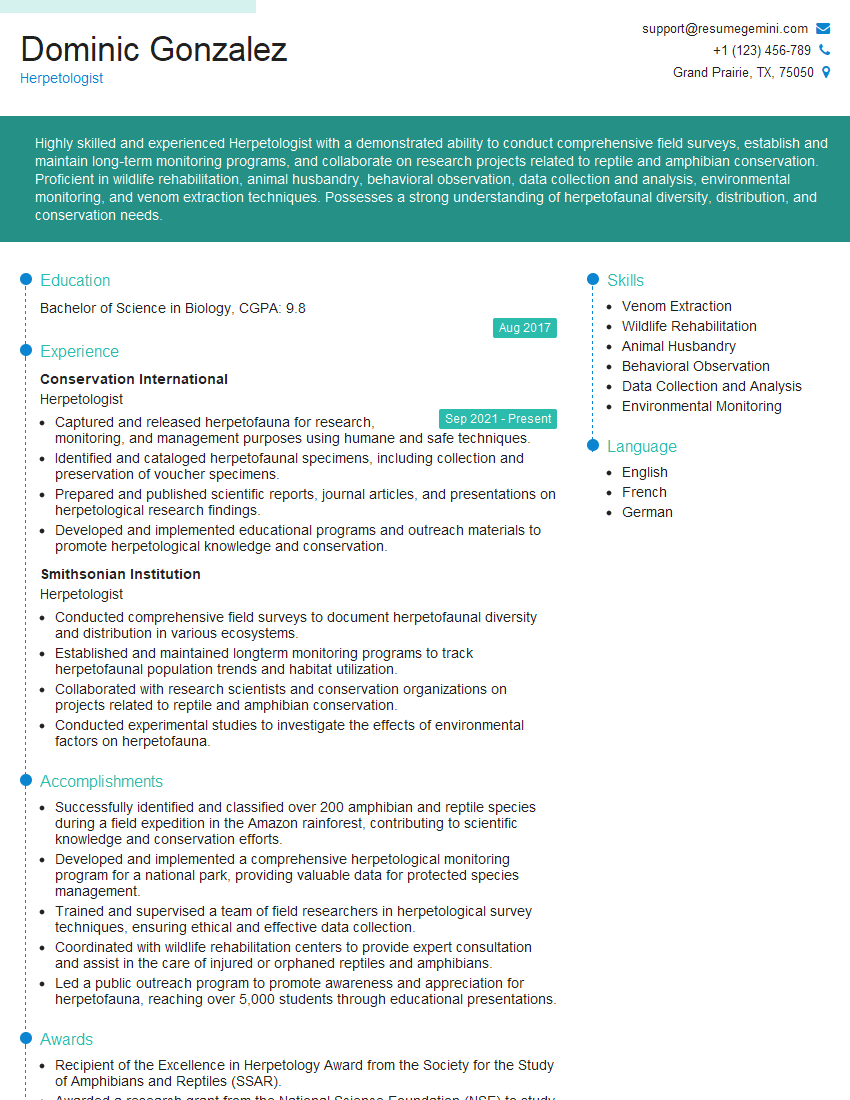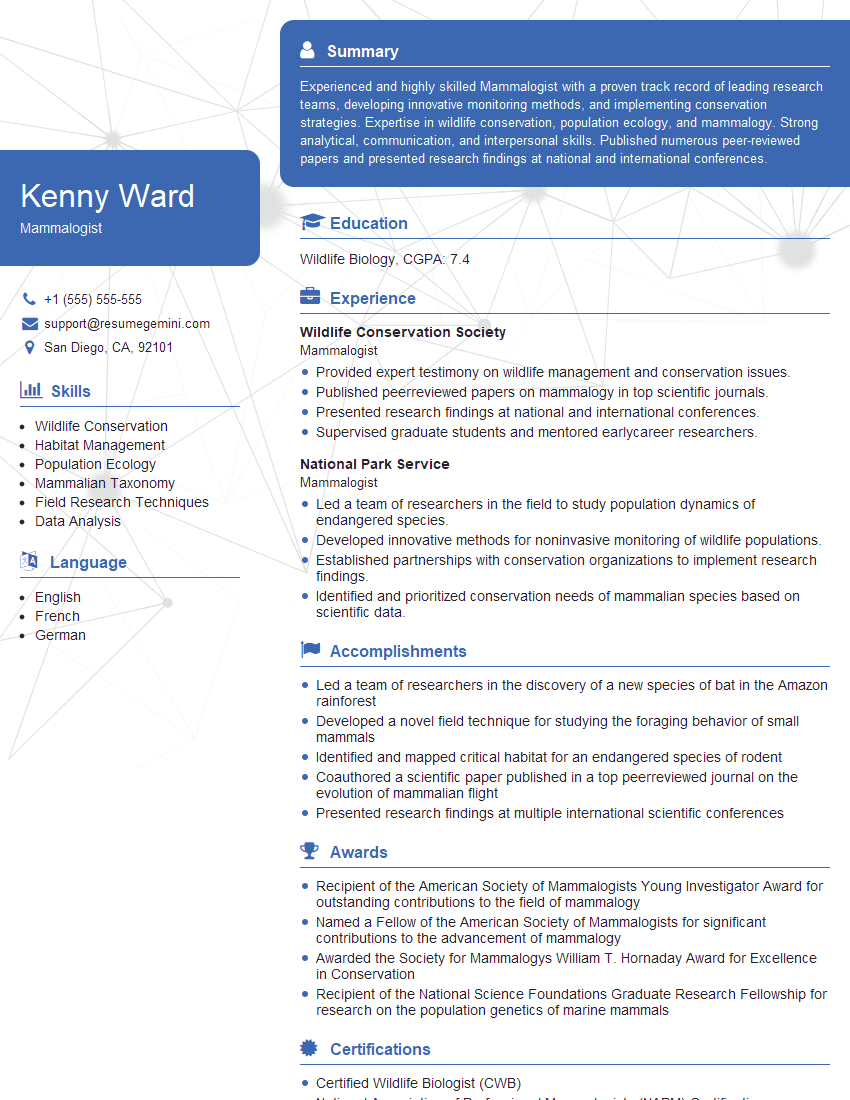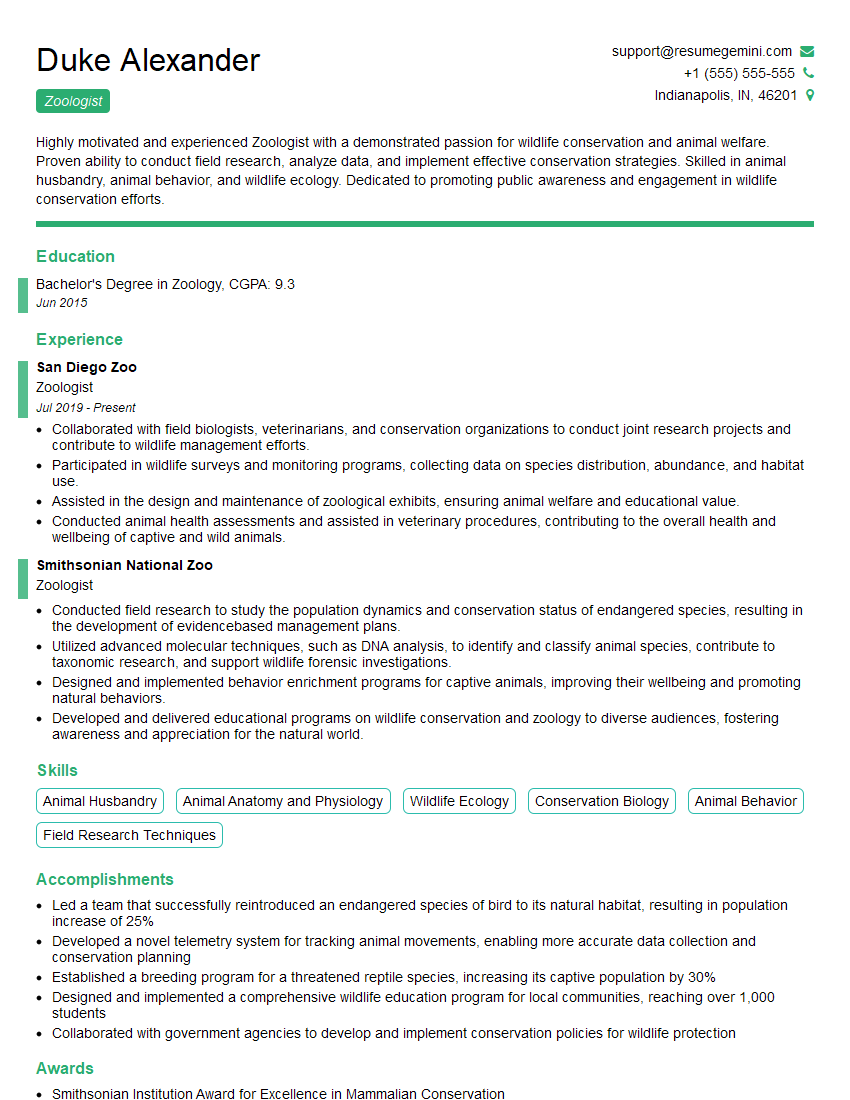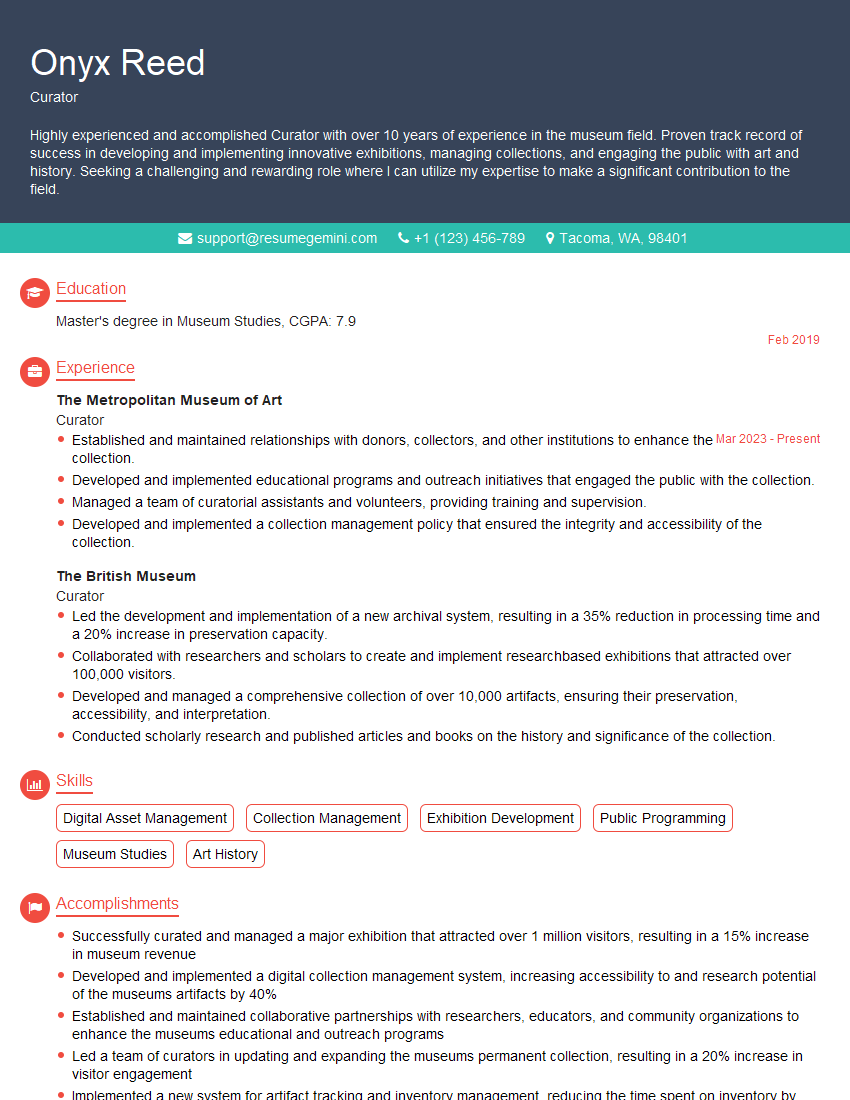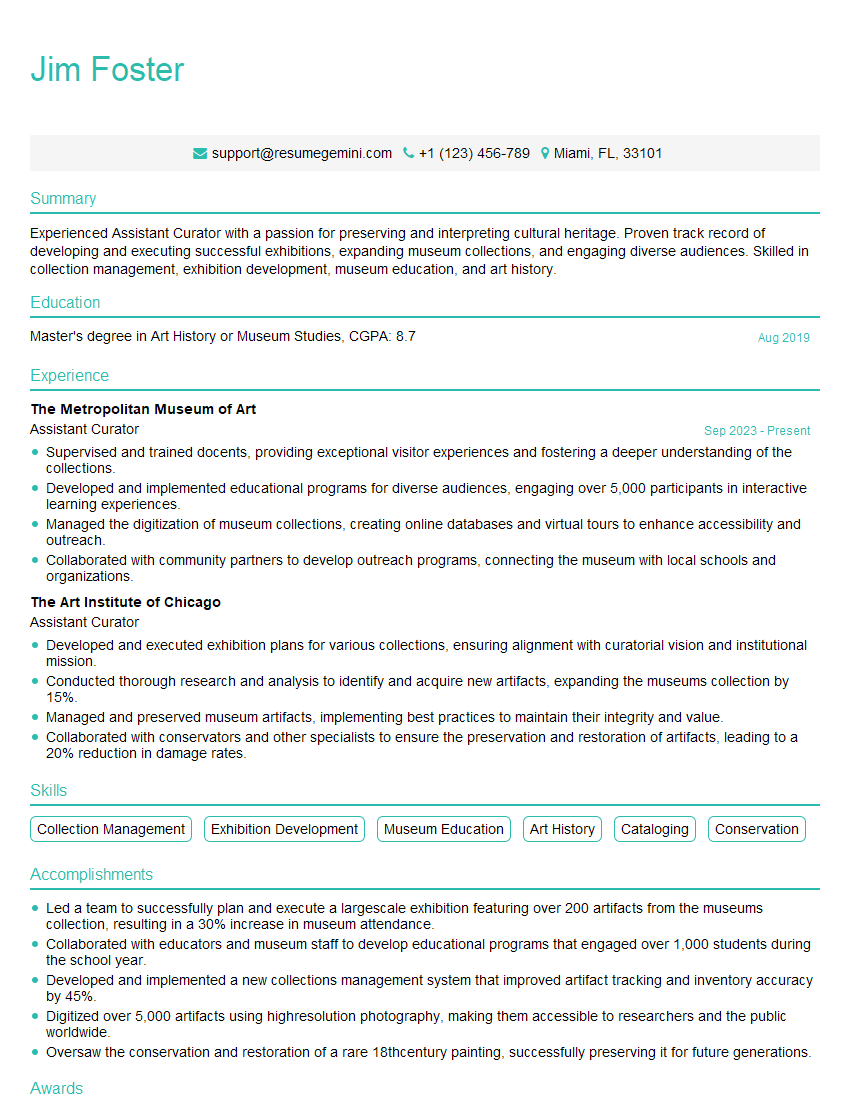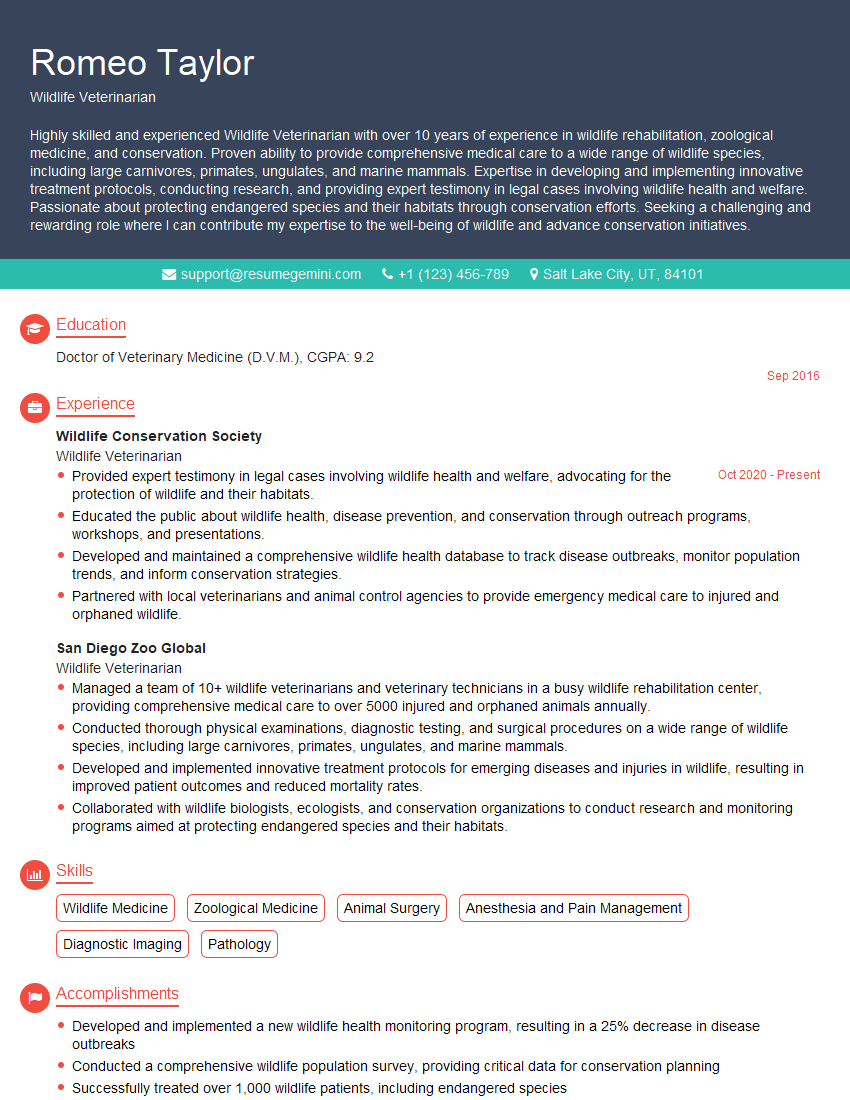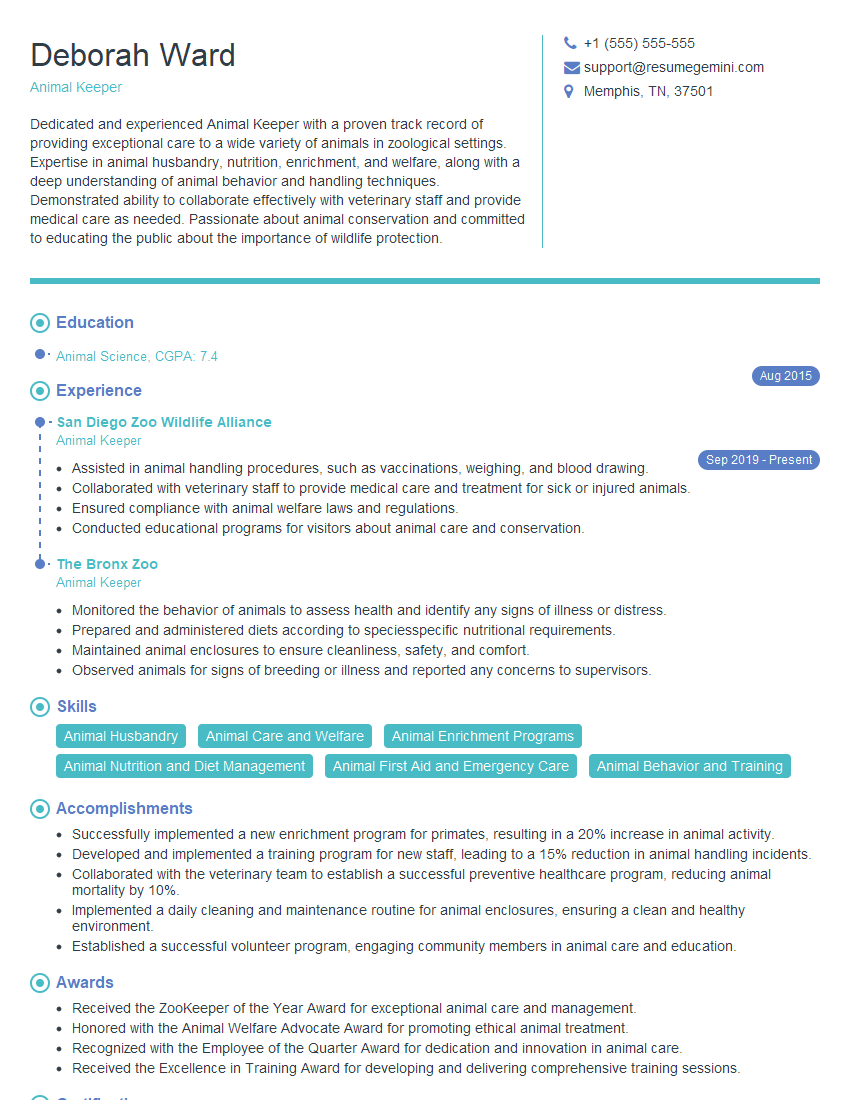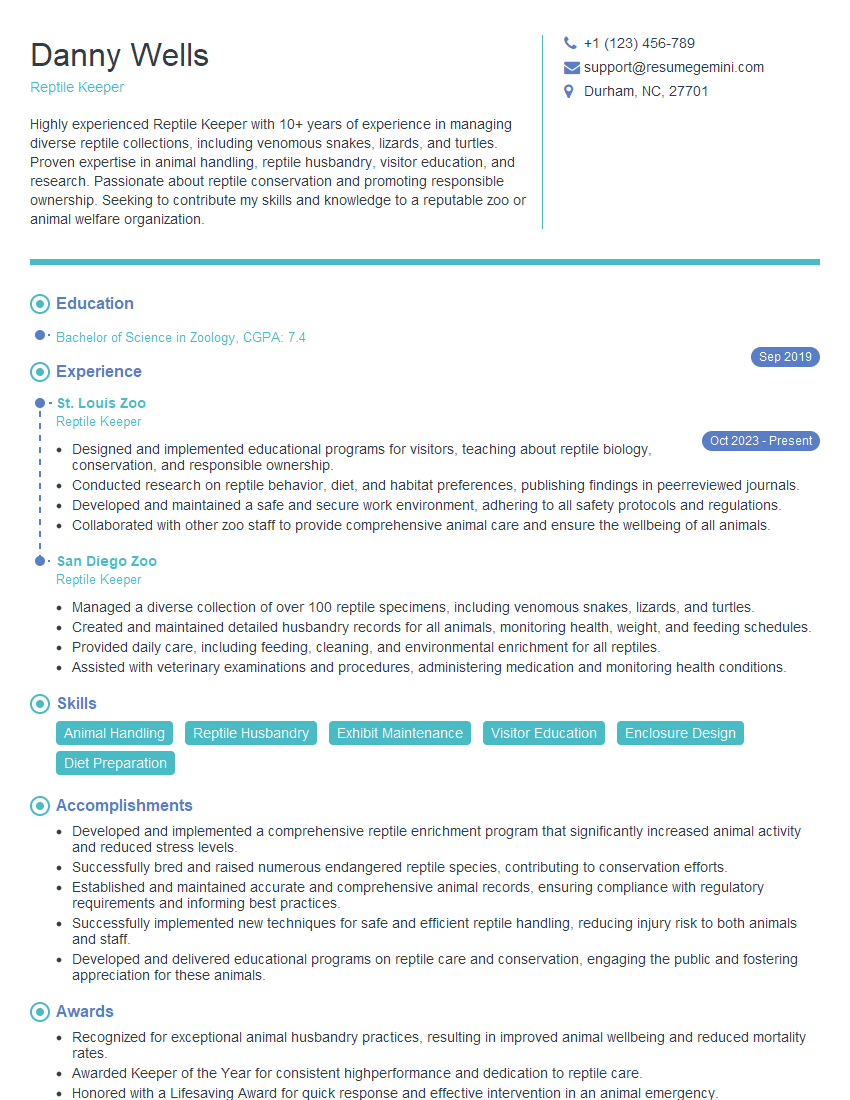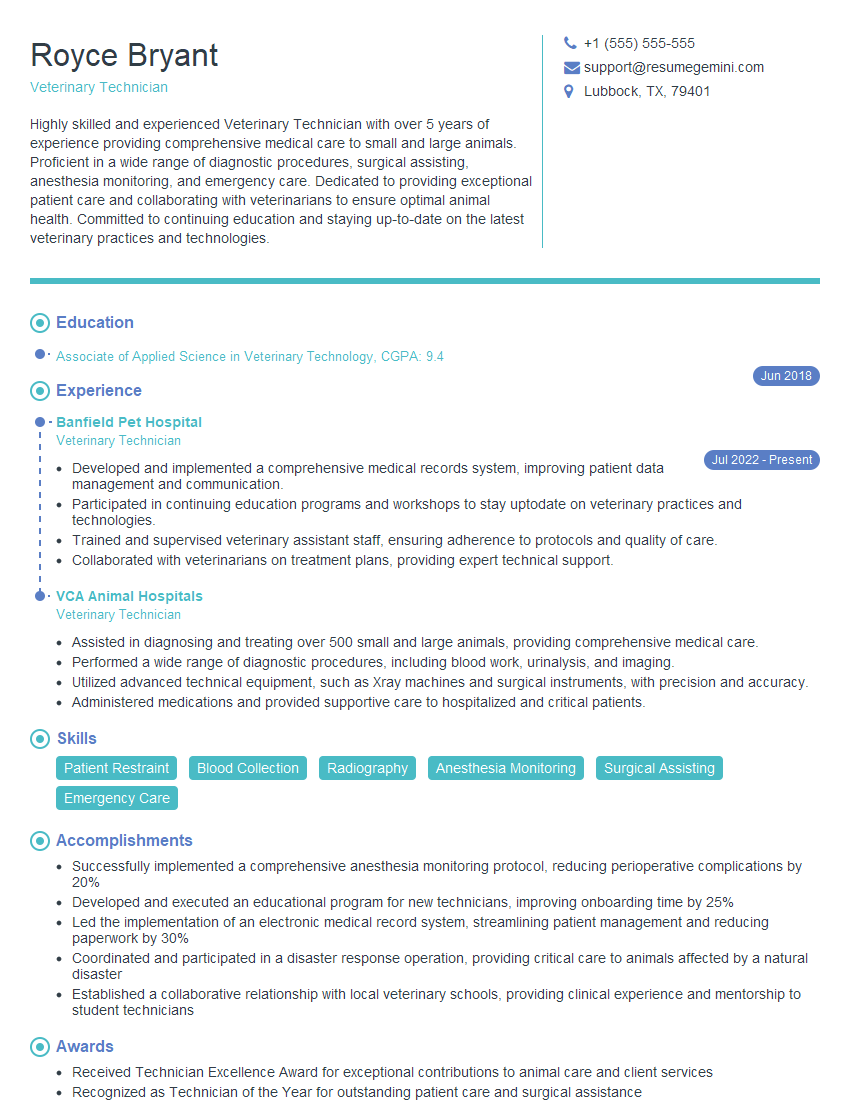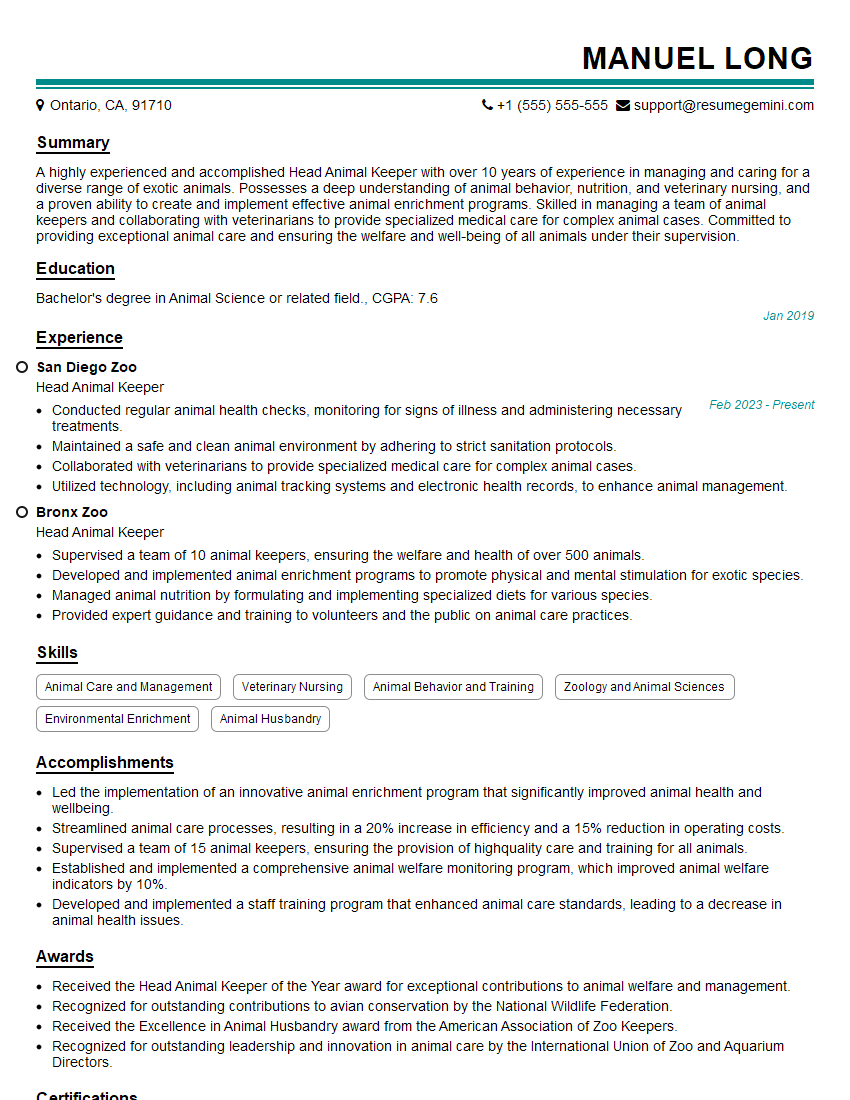The thought of an interview can be nerve-wracking, but the right preparation can make all the difference. Explore this comprehensive guide to Zoo Animal Care interview questions and gain the confidence you need to showcase your abilities and secure the role.
Questions Asked in Zoo Animal Care Interview
Q 1. Describe your experience with animal enrichment programs.
Animal enrichment is crucial for maintaining the physical and psychological well-being of zoo animals. It involves providing stimulating environments and activities that mimic natural behaviors and challenges. My experience encompasses designing and implementing enrichment programs for a diverse range of species, from primates requiring complex social interaction puzzles to big cats needing opportunities for scent marking and hunting simulations.
- Example 1: For our orangutans, we introduced a foraging enrichment program using puzzle feeders filled with their favorite fruits and vegetables. This encouraged natural foraging behaviors, increased their activity levels, and reduced stereotypical behaviors like pacing.
- Example 2: With our snow leopards, we implemented environmental enrichment by creating varied terrain within their enclosure, including climbing structures and hiding places. This stimulated their natural hunting instincts and provided opportunities for exploration and play, decreasing boredom and stress.
I meticulously document the effectiveness of each enrichment activity, observing animal responses and adjusting the program based on the data collected. Success is measured by increased engagement, reduced stereotypical behaviors, and overall improved animal welfare.
Q 2. Explain the importance of proper animal nutrition.
Proper nutrition is the cornerstone of animal health in zoos. It’s about providing a diet that meets the animal’s specific nutritional needs based on its species, age, sex, and health status. A balanced diet prevents disease, supports optimal growth and development, and enhances reproductive success. Inadequate nutrition can lead to weakened immunity, stunted growth, and various health problems.
My approach involves collaborating with veterinary nutritionists to develop species-specific diet plans. These plans consider factors such as protein, fat, carbohydrate requirements, and essential vitamins and minerals. We use high-quality, fresh ingredients whenever possible. For example, we carefully monitor the calorie content and nutrient composition of diets for our herbivores, ensuring they receive adequate fiber and micronutrients. Regularly monitoring their weight, body condition scores, and fecal consistency helps us ensure the dietary program is effective.
Regular blood tests and fecal analyses further help us assess the efficacy of the nutritional program and make necessary adjustments. For instance, a low blood calcium level in a reptile might indicate a need to supplement its diet. We use sophisticated software to manage diet records and ensure each animal receives its precise dietary requirements.
Q 3. How do you handle aggressive or stressed animals?
Handling aggressive or stressed animals requires a calm, patient, and informed approach, prioritizing safety for both the animal and staff. The first step is to understand the root cause of the aggression or stress. Is it illness, fear, territoriality, or a response to environmental factors?
- Assessment: We carefully observe the animal’s body language, paying attention to posture, vocalizations, and overall behavior to determine the reason behind the aggression or stress. This might involve reviewing environmental factors, recent changes to the enclosure, social dynamics, or even prior experiences of the animal.
- Mitigation Strategies: We might employ techniques such as providing increased space or hiding places, modifying the environment to reduce stressors, introducing calming pheromones, or using positive reinforcement training. For example, we may use positive reinforcement training to teach an animal to voluntarily enter a transport crate for medical treatment.
- Safety Protocols: When necessary, we use appropriate restraint techniques and protective equipment, always following established safety protocols. This often involves a trained team and using specialized tools designed for specific species and situations.
If the aggression or stress is severe or persistent, we consult with our veterinary team to rule out underlying medical conditions and determine appropriate management strategies.
Q 4. What are the signs of illness or injury in animals under your care?
Recognizing signs of illness or injury is a critical skill for zoo animal keepers. Regular observation is paramount, as early detection can significantly improve treatment outcomes. The subtle changes can be as important as overt signs.
- Behavioral Changes: Lethargy, loss of appetite, changes in vocalizations, unusual social interactions, or withdrawal are crucial indicators. For instance, a normally playful monkey becoming withdrawn and quiet could be a sign of illness.
- Physical Changes: Changes in weight, body condition, coat condition, respiratory rate, and fecal consistency are also significant indicators. Visible injuries like wounds, swelling, or lameness require immediate attention.
- Other Signs: Discharge from eyes or nose, diarrhea, vomiting, labored breathing, or unusual urination should raise immediate concern. We are trained to use different techniques for assessing each species appropriately, recognizing subtle signs that vary amongst species.
Any suspected illness or injury requires immediate reporting to the veterinary staff, who conduct a thorough examination, run diagnostic tests (such as blood tests or X-rays), and formulate a treatment plan.
Q 5. Describe your experience with animal record-keeping and data entry.
Accurate and thorough record-keeping is fundamental to effective zoo animal care. We maintain detailed records for each animal, encompassing medical history, dietary information, behavioral observations, and enrichment activities. This information is critical for tracking animal health, assessing the effectiveness of enrichment programs, and for research purposes.
We utilize specialized software designed for zoo animal management, inputting data on a daily or even more frequent basis. This includes information on weight, food consumption, medication administration, and any unusual behavioral observations. We utilize various data entry methods to maintain accuracy and efficiency. We employ strict protocols to ensure that data is accurate, consistent, and securely stored, following all privacy guidelines. This data is essential for making informed decisions about animal care, research, and overall zoo management. For example, tracking weight changes helps us identify potential health problems early on, while detailed enrichment records help us evaluate their effectiveness.
Q 6. How do you maintain a clean and sanitary environment for the animals?
Maintaining a clean and sanitary environment is essential for preventing the spread of disease and ensuring the well-being of our animals. We employ a rigorous cleaning and disinfection protocol for all enclosures, which varies depending on the species and their specific needs.
- Daily Cleaning: This involves removing waste, uneaten food, and soiled bedding.
- Regular Disinfection: We use approved disinfectants according to manufacturer guidelines to eliminate pathogens.
- Enclosure Design: Enclosures are designed to facilitate easy cleaning and minimize areas where pathogens can accumulate.
- Pest Control: Regular pest control measures are implemented to prevent infestations.
We train staff on proper cleaning and disinfection techniques, emphasizing the importance of personal protective equipment (PPE) to prevent the transmission of pathogens. Our procedures align with best practices for zoo animal hygiene and are regularly audited for compliance.
Q 7. Explain your understanding of quarantine procedures for new animals.
Quarantine procedures are essential for protecting the health of existing animals from potential diseases that could be introduced by new arrivals. All new animals undergo a mandatory quarantine period before being integrated into the main collection.
During quarantine, animals undergo a thorough veterinary examination, including diagnostic testing (bloodwork, fecal tests, etc.). They are housed in separate, isolated facilities to prevent contact with other animals. Their behavior and health are carefully monitored throughout the quarantine period. Any signs of illness or infection are treated promptly to avoid an outbreak. The duration of quarantine varies depending on species, the animal’s origin, and health assessment. The length of quarantine may also be extended if any health issues are detected. Only after successfully completing the quarantine period and receiving a clean bill of health are new animals integrated into their respective enclosures.
Q 8. How do you ensure the safety of both animals and staff?
Ensuring the safety of both animals and staff in a zoo setting is paramount and requires a multi-faceted approach. It’s not just about physical safety, but also psychological well-being. We achieve this through a combination of robust protocols, training, and infrastructure.
- Barrier Systems: Secure enclosures designed to prevent escapes and unauthorized access are fundamental. This includes sturdy fencing, reinforced habitats, and appropriate locking mechanisms. For example, primate enclosures often feature multiple layers of barriers to contain potentially agile animals.
- Behavioral Management: Understanding animal behavior is crucial. We use enrichment programs to keep animals mentally stimulated, reducing stress-induced aggression. For instance, providing puzzle feeders for bears or rotating toys for primates can significantly decrease boredom and increase safety.
- Staff Training: Extensive training programs for zookeepers cover safe handling techniques, emergency protocols, and animal behavior interpretation. Regular refreshers and practical demonstrations ensure staff are always prepared. For example, we simulate emergency scenarios, like a sudden enclosure malfunction, to practice safe response techniques.
- Emergency Response Plans: Detailed emergency plans addressing various scenarios, including animal escapes, medical emergencies, and natural disasters, are essential. These plans outline clear procedures and communication channels, ensuring a coordinated response. Regular drills help refine the efficiency of these plans.
Q 9. Describe your experience with animal training techniques.
My experience with animal training encompasses a range of positive reinforcement techniques, focusing on building trust and understanding between animals and keepers. I’ve worked extensively with positive reinforcement, using rewards (food, toys, praise) to shape desirable behaviors and discourage undesirable ones.
- Operant Conditioning: This is the cornerstone of my training methodology. We use it to teach animals specific behaviors, such as presenting for medical examinations or participating in training sessions. For example, a sea lion might learn to target a specific spot on its body to make administering medication easier.
- Target Training: Using a target (a stick or hand signal) to guide an animal into desired positions is incredibly effective. This is beneficial for moving animals for cleaning or veterinary care. I’ve successfully used this with various species, from birds to big cats.
- Shaping: This involves breaking down complex behaviors into smaller, manageable steps. For example, teaching a giraffe to voluntarily enter a transport crate involves rewarding successive approximations, starting with simply approaching the crate.
I believe in creating a safe, positive environment where animals are motivated to participate willingly, rather than through force or coercion.
Q 10. What is your experience with animal restraint and handling?
Animal restraint and handling are crucial aspects of zookeeping, primarily used during medical examinations, transport, or emergency situations. Safety for both the animal and the handler is paramount. I’ve been trained in species-specific techniques, prioritizing minimizing stress and potential harm.
- Species-Specific Techniques: The methods employed vary considerably depending on the species. Restraining a large primate requires entirely different techniques from handling a reptile or bird. I’m proficient in many species-specific handling methods, emphasizing safety and minimizing stress on the animal.
- Chemical Restraint: In situations where physical restraint is impractical or too risky, chemical restraint (using tranquilizers) might be necessary. This requires expert knowledge of drug dosages and careful monitoring of the animal’s vital signs. It’s used as a last resort, always prioritizing the animal’s well-being.
- Safety Equipment: The use of appropriate safety equipment, such as protective clothing, specialized tools, and harnesses, is critical. This reduces the risk of injury to both the animal and the handler. The equipment varies widely based on the species being handled.
Each procedure is meticulously planned and executed, considering the individual animal’s temperament and medical history.
Q 11. How familiar are you with different animal species’ specific needs?
My familiarity with different animal species’ specific needs is extensive. It’s not just about knowing what they eat; it’s about understanding their complex social structures, behavioral patterns, environmental requirements, and potential health challenges. This knowledge forms the foundation of successful animal husbandry.
- Dietary Requirements: Each species has unique nutritional needs. I have experience creating species-appropriate diets, ensuring proper balance of nutrients, vitamins, and minerals. For instance, carnivores require a different diet than herbivores.
- Environmental Enrichment: Creating stimulating and engaging environments crucial for an animal’s physical and psychological well-being. This includes providing appropriate substrates, climbing structures, hiding places, and social interaction opportunities. For example, providing a variety of toys for primates helps them stay mentally stimulated.
- Health Monitoring: I have a keen understanding of common health problems for various animal species and am proficient in recognizing and addressing these concerns. Regular monitoring, including observation of behavior, weight changes, and fecal exams, is crucial.
Understanding these varied needs enables me to create optimal living conditions and provide the best possible care for each species.
Q 12. How do you handle emergency situations involving animals?
Handling emergency situations involving animals requires swift, decisive action based on a calm assessment of the situation. My training emphasizes preparedness and the ability to react effectively under pressure.
- Assessment: The first step is a rapid assessment of the situation – identifying the nature of the emergency, the animal involved, and any potential hazards. Is the animal injured? Is there an immediate threat to staff or other animals?
- Immediate Action: Based on the assessment, immediate actions are taken. This might involve isolating the animal, administering first aid, contacting veterinary staff, or activating emergency response protocols. For instance, if an animal escapes, securing the area and safely containing the animal takes precedence.
- Veterinary Care: Collaboration with veterinary staff is critical in most emergencies. This ensures timely diagnosis and treatment.
- Post-Incident Review: After the emergency, a thorough review is conducted. This involves analyzing what happened, identifying areas for improvement in procedures or training, and updating emergency plans accordingly. This is vital for continuous improvement and minimizing future risks.
Regular drills and practice scenarios help us prepare for a wide range of emergencies, ensuring effective and safe responses.
Q 13. What is your experience with public education and outreach programs?
Public education and outreach are crucial components of zoo work. I believe strongly in engaging the public to foster conservation awareness and promote responsible stewardship of wildlife. My experience includes developing and delivering educational programs for diverse audiences.
- Educational Programs: I have experience developing and delivering educational programs tailored to different age groups and interests. This includes guided tours, interactive workshops, educational presentations, and hands-on activities. For example, I’ve developed programs focused on the conservation of endangered species, highlighting the importance of their habitats.
- Community Outreach: I’ve participated in community outreach events, sharing information about zoo conservation efforts and engaging the public through interactive displays and presentations.
- Curriculum Development: I’ve contributed to the development of educational materials, including brochures, websites, and educational resources. For example, I helped create an educational package on animal welfare for schools.
My goal is to inspire a sense of wonder and respect for wildlife, fostering a community committed to conservation.
Q 14. How do you contribute to the conservation of endangered species?
Contributing to the conservation of endangered species is a core value of my profession. My efforts extend beyond daily animal care to include active participation in conservation initiatives.
- Species Survival Plans (SSPs): I actively participate in SSPs, contributing to breeding programs aimed at increasing the population of endangered animals within carefully managed programs. This involves detailed record-keeping, genetic management, and collaboration with other zoos globally.
- Habitat Conservation: I support habitat conservation efforts through collaborations with conservation organizations. This might involve funding, providing expertise, or participating in fieldwork to protect endangered species in their natural environments. For instance, supporting reforestation efforts to rebuild crucial habitat.
- Research and Data Collection: I participate in research projects, contributing to data collection that informs conservation strategies. For example, contributing data on animal behavior or reproductive success to inform breeding programs.
- Advocacy and Education: Through public education programs, I advocate for the protection of endangered species and raise awareness of the threats they face, promoting responsible environmental practices.
Conservation is a team effort, and I’m committed to playing a significant role in protecting these precious species for future generations.
Q 15. Describe your experience working with veterinary staff.
My experience working with veterinary staff has been extensive and collaborative. It’s crucial for optimal animal care that we maintain open communication and a seamless workflow between animal care staff and the veterinary team. This involves regular consultations about animal health concerns, assisting with examinations and treatments, and meticulously documenting observations and any changes in an animal’s condition. For instance, at my previous role, I worked closely with our veterinary team to manage a geriatric orangutan with arthritis. This involved coordinating daily medication administration, monitoring his mobility and comfort levels, and modifying his enclosure to minimize stress and improve his quality of life. We developed a treatment plan together, involving both medication and environmental enrichment to improve his mobility. We also collaborated on a successful breeding program for endangered species, where veterinary expertise on reproductive health was critical to success.
Career Expert Tips:
- Ace those interviews! Prepare effectively by reviewing the Top 50 Most Common Interview Questions on ResumeGemini.
- Navigate your job search with confidence! Explore a wide range of Career Tips on ResumeGemini. Learn about common challenges and recommendations to overcome them.
- Craft the perfect resume! Master the Art of Resume Writing with ResumeGemini’s guide. Showcase your unique qualifications and achievements effectively.
- Don’t miss out on holiday savings! Build your dream resume with ResumeGemini’s ATS optimized templates.
Q 16. How do you manage a diverse team of animal care professionals?
Managing a diverse team of animal care professionals requires strong leadership, effective communication, and a commitment to fostering a positive and collaborative work environment. I believe in empowering my team members, recognizing their individual strengths and providing opportunities for professional development. Regular team meetings, where everyone feels comfortable contributing, are essential. Open communication channels are key to addressing concerns promptly and efficiently. We utilize a task management system to ensure clarity and accountability. For example, I implemented a system of daily reports for each animal, where caretakers record observations and any treatments. This ensures a continuity of care and helps identify potential problems early on. I also emphasize the importance of teamwork and mutual support – we work as a unit to provide the best possible care for our animals.
Q 17. What is your experience with animal breeding and reproductive programs?
My experience with animal breeding and reproductive programs includes participation in several successful breeding initiatives for both common and endangered species. This involves careful monitoring of animal behavior and reproductive cycles, maintaining detailed records of breeding pairings, and assisting with artificial insemination when necessary. For example, I was part of a team that successfully bred a pair of critically endangered Amur leopards. This involved meticulous record-keeping, creating an enriched environment to stimulate natural breeding behaviors, and collaborating closely with the veterinary staff to monitor the female’s health and pregnancy. We used specialized technology, including ultrasound, to monitor fetal development and ensured a safe birthing environment for both mother and cub. Successful breeding programs require not only biological understanding but also careful planning and management of resources.
Q 18. How do you monitor animal health and behavior?
Monitoring animal health and behavior is an ongoing process that involves keen observation and record-keeping. Daily observations, including visual inspections, weight checks, and appetite monitoring, are crucial for early detection of illness or changes in behavior. Any unusual behavior is documented, and changes in activity level, eating habits, or social interactions are noted. These observations are then reviewed by the veterinary staff to determine if any further investigations are required. In addition, we use technology such as automated feeding systems and activity trackers to monitor animal behavior and health remotely. We also incorporate enrichment activities to stimulate natural behaviors and enhance the overall well-being of our animals. For example, a sudden decrease in food intake by a primate could indicate illness or stress, prompting a thorough veterinary examination and a review of its environment and social interactions. Early detection through careful observation is vital for effective intervention.
Q 19. Explain your understanding of animal welfare regulations.
My understanding of animal welfare regulations is comprehensive and constantly updated. I am familiar with the AZA (Association of Zoos and Aquariums) standards, as well as federal and state regulations regarding animal care and handling. These regulations cover various aspects, including housing, nutrition, enrichment, veterinary care, and transportation. Compliance is paramount, and I prioritize creating a culture of safety and well-being for the animals under our care. Regular audits and internal reviews ensure that we meet or exceed these standards. For example, we adhere strictly to protocols for quarantine, disease prevention, and humane euthanasia when necessary, ensuring ethical and responsible treatment of animals throughout their lives. Knowledge of these regulations is essential for ensuring high standards of animal welfare and maintaining a legally compliant operation.
Q 20. How do you deal with conflict resolution in the workplace?
Conflict resolution is an essential skill in any team environment. My approach emphasizes open communication and finding mutually agreeable solutions. I encourage team members to express their concerns openly and respectfully, while providing a safe and neutral space for discussion. When conflicts arise, I focus on understanding the root cause of the problem, rather than simply addressing the symptoms. I often facilitate discussions, employing active listening techniques to ensure all parties feel heard and understood. If necessary, I may mediate the conversation, helping to identify common ground and develop a compromise. For example, if there’s a disagreement on the best approach to managing a particular animal’s behavior, I would facilitate a discussion between the involved caretakers, drawing on their expertise and experience to find a solution that prioritizes the animal’s well-being.
Q 21. Describe your experience with the use of technology in animal care.
Technology plays an increasingly important role in modern animal care. We utilize various technologies to enhance animal welfare, improve operational efficiency, and expand our understanding of animal behavior. Examples include:
- Automated feeding systems: These systems ensure precise and consistent food distribution, improving animal nutrition and reducing staff workload.
- Activity monitors: These devices track animal movement, providing valuable insights into activity patterns and overall health.
- GPS tracking systems (for certain animals): Useful for monitoring location and behavior patterns of animals in larger enclosures.
- Veterinary diagnostic tools: Advanced imaging technology such as ultrasound and X-rays allows for early disease detection and improves treatment efficacy.
- Environmental control systems: These systems help to maintain optimal environmental conditions, contributing to the comfort and well-being of the animals.
Q 22. How do you balance the needs of the animals with the needs of the visitors?
Balancing animal welfare and visitor experience is crucial in zoo management. It’s a delicate dance, prioritizing the animals’ physical and psychological well-being while ensuring visitors have an enriching and safe experience. We achieve this through careful planning and execution of several strategies.
Habitat Design: Exhibit design plays a key role. Habitats are created to mimic the animals’ natural environments, providing ample space for natural behaviors. Viewing areas are strategically placed to minimize animal stress while maximizing visitor engagement. For instance, creating natural barriers like foliage allows animals to retreat from direct observation when needed.
Enrichment Programs: We implement diverse enrichment activities to stimulate animals both physically and mentally. This could include puzzle feeders, scent trails, or social interactions (where appropriate). These enrichments can be timed to coincide with less busy visitor hours, reducing disturbance.
Visitor Education: Clear signage and educational programs inform visitors about the animals’ needs and encourage respectful viewing behaviors. For example, signs reminding visitors to keep quiet or maintain a safe distance are crucial. Dedicated educational staff can also address visitor questions and foster responsible engagement.
Staff Training: Our staff receives extensive training in animal behavior and visitor management. They’re equipped to recognize signs of animal stress and intervene appropriately. This may involve diverting visitors or temporarily closing viewing areas. In short, we empower our team to act as the first line of defense for animal welfare.
Q 23. What is your experience with preventative animal healthcare?
Preventative healthcare is the cornerstone of responsible zoo animal management. It’s a proactive approach that significantly reduces the incidence and severity of disease, leading to healthier and happier animals. My experience encompasses a wide range of practices.
Routine Checkups: This includes regular physical examinations, weight monitoring, and fecal analyses, allowing us to detect potential health issues early on. For example, early detection of parasites through fecal exams can prevent a widespread infestation within the animal population.
Vaccination Programs: We adhere to strict vaccination schedules tailored to each species, protecting them from contagious diseases. We maintain meticulous records to ensure each animal receives appropriate vaccinations at the right time.
Nutritional Management: Providing a balanced and species-appropriate diet is crucial. This involves careful consideration of the animals’ nutritional requirements, adapting diets based on age, health, and environmental factors. An example is adjusting the diet of a pregnant animal to meet the increased demands of her body and developing fetus.
Parasite Control: Regular deworming and preventative measures against external parasites (like ticks and fleas) are crucial to maintaining animal health. We use strategic parasite control methodologies to avoid developing resistant parasite populations.
Environmental Hygiene: Maintaining clean and sanitary enclosures is paramount. Regular cleaning and disinfection schedules reduce the risk of infectious diseases. It also involves appropriate waste management systems.
Q 24. How do you stay updated on the latest developments in animal care?
Staying abreast of the latest developments in animal care is an ongoing commitment. It’s crucial for providing the best possible care to the animals under my charge. I utilize several strategies to stay informed.
Professional Conferences and Workshops: Actively attending conferences and workshops hosted by organizations like the Association of Zoos and Aquariums (AZA) allows me to network with colleagues and learn about new research and best practices.
Peer-Reviewed Journals and Scientific Publications: I regularly read scientific journals and publications to stay updated on the latest research findings in animal health, behavior, and welfare. This ensures I remain at the forefront of scientific advancements in my field.
Online Resources and Professional Networks: I engage with online communities and professional networks, participating in discussions and learning from the experiences of other professionals in the field. This allows for continued learning and collaboration.
Mentorship and Collaboration: I maintain close contact with experienced colleagues and mentors, seeking their expertise and guidance on challenging cases or new developments. This collaborative environment fosters learning and shared best practices.
Q 25. Describe your experience with budgeting and resource management.
Budgeting and resource management are critical aspects of zoo operations. Effective resource allocation directly impacts animal welfare, staff morale, and the overall visitor experience. My experience includes:
Budget Development and Monitoring: I’m proficient in developing and monitoring budgets, ensuring funds are allocated efficiently and effectively across various departments (animal care, veterinary services, education, etc.). I utilize budgeting software to track expenses and revenue.
Resource Prioritization: I prioritize resource allocation based on the animals’ most critical needs, considering factors like age, health status, and species-specific requirements. For example, prioritizing funds for a critically endangered species’ breeding program would be a crucial allocation decision.
Grant Writing and Fundraising: I have experience securing funding through grant applications and fundraising initiatives, supplementing operational budgets and enhancing our capabilities.
Inventory Management: I’m skilled in managing inventory, ensuring that essential supplies (food, medication, enrichment materials) are always readily available. This includes optimizing storage solutions and preventing waste.
Q 26. How do you prioritize tasks in a fast-paced environment?
Prioritizing tasks in a fast-paced zoo environment requires a structured approach. I employ several strategies to effectively manage competing demands:
Task Categorization: I categorize tasks by urgency and importance (using methods like Eisenhower Matrix). Urgent and important tasks (e.g., responding to a medical emergency) always take precedence.
Time Management Techniques: I utilize time-management techniques like time blocking and the Pomodoro Technique to allocate dedicated time slots for specific tasks, enhancing productivity and focus.
Delegation: I delegate tasks effectively to my team, empowering them to contribute their expertise and freeing up time for tasks requiring my specific attention.
Teamwork and Collaboration: I foster a collaborative environment, encouraging open communication and teamwork. This ensures that everyone is informed about priorities and works together towards shared goals.
Flexibility and Adaptability: In a zoo setting, unexpected events are common. I am adaptable and readily adjust my priorities to handle emergencies or unforeseen circumstances.
Q 27. How would you handle a situation where a visitor is behaving inappropriately near the animals?
Addressing inappropriate visitor behavior near animals requires a calm and professional approach. Safety is paramount, both for the animals and the visitors. My approach would be:
Direct Observation: I would carefully observe the situation to assess the severity of the inappropriate behavior and any potential risks to the animal.
Verbal Intervention: I would calmly and politely address the visitor, explaining the potential dangers of their actions to the animal’s well-being. I would emphasize the importance of respecting animal space and following zoo guidelines.
Escalation if Necessary: If verbal intervention is ineffective, I would involve security personnel or other management staff for further assistance. Depending on the severity of the situation, we might issue warnings or remove the visitor from the premises.
Animal Assessment: Following the incident, I would observe the animal closely to assess for any signs of stress or distress caused by the visitor’s behavior.
Reporting and Documentation: I would document the incident, including details of the visitor’s behavior, interventions taken, and the animal’s subsequent response. This documentation helps identify trends, refine visitor management strategies and ensures appropriate measures are put in place.
Q 28. What are your salary expectations for this role?
My salary expectations for this role are commensurate with my experience, skills, and the responsibilities associated with this position. I am comfortable discussing a specific salary range after learning more about the compensation package and benefits offered.
Key Topics to Learn for Your Zoo Animal Care Interview
- Animal Husbandry: Understanding the specific needs of diverse animal species, including diet, housing, enrichment, and health monitoring. Practical application: Describe your experience in providing optimal care based on species-specific requirements.
- Animal Behavior and Welfare: Recognizing normal and abnormal behavior, implementing enrichment programs to promote psychological well-being, and identifying potential health issues through behavioral observation. Practical application: Explain how you’ve used behavioral observations to assess animal welfare and make adjustments to their care.
- Disease Prevention and Management: Knowledge of common zoo animal diseases, quarantine procedures, vaccination protocols, and biosecurity measures. Practical application: Describe your experience in maintaining a clean and safe environment to prevent disease outbreaks.
- Record Keeping and Data Management: Accurate and detailed record-keeping of animal health, feeding, behavior, and any other relevant information. Practical application: Explain your proficiency in using software or systems for maintaining detailed animal records.
- Emergency Response and First Aid: Understanding emergency protocols, administering basic first aid to animals, and collaborating with veterinary staff. Practical application: Describe your experience handling animal emergencies and your understanding of appropriate response procedures.
- Teamwork and Communication: Effective collaboration with zookeepers, veterinarians, and other staff members. Practical application: Explain how you work effectively as part of a team to provide the best possible care for animals.
- Conservation and Education: Understanding the role of zoos in conservation efforts and public education. Practical application: Discuss your interest in conservation and your experience with educating the public about animals.
Next Steps
Mastering Zoo Animal Care is crucial for a successful and rewarding career. It opens doors to specialized roles, leadership opportunities, and contributions to global conservation efforts. To significantly increase your job prospects, crafting an ATS-friendly resume is paramount. ResumeGemini is a trusted resource to help you build a professional resume that highlights your skills and experience effectively. We provide examples of resumes tailored specifically to Zoo Animal Care to give you a head start. Invest time in creating a compelling resume—it’s your first impression on potential employers.
Explore more articles
Users Rating of Our Blogs
Share Your Experience
We value your feedback! Please rate our content and share your thoughts (optional).
What Readers Say About Our Blog
Hi, I’m Jay, we have a few potential clients that are interested in your services, thought you might be a good fit. I’d love to talk about the details, when do you have time to talk?
Best,
Jay
Founder | CEO
